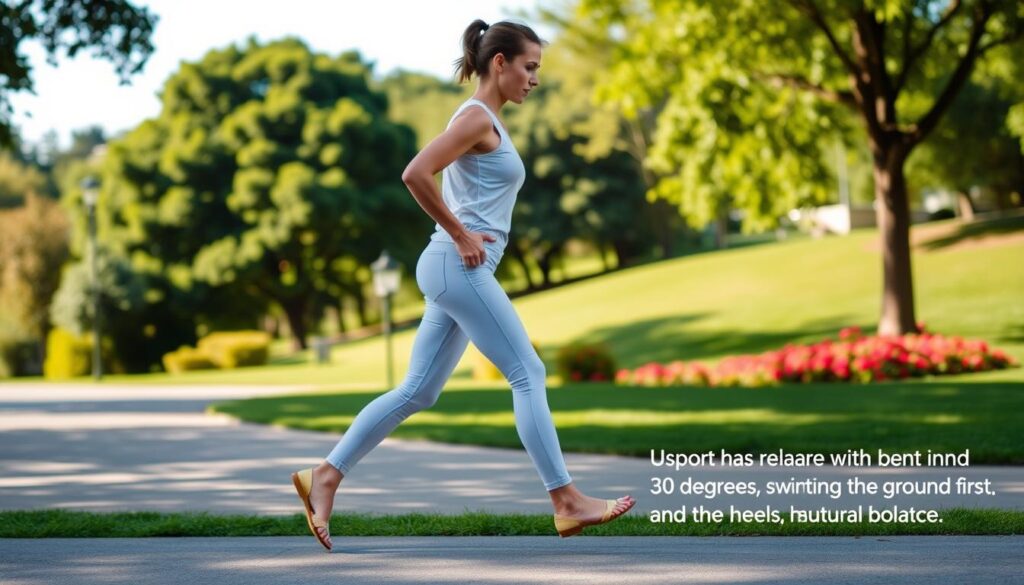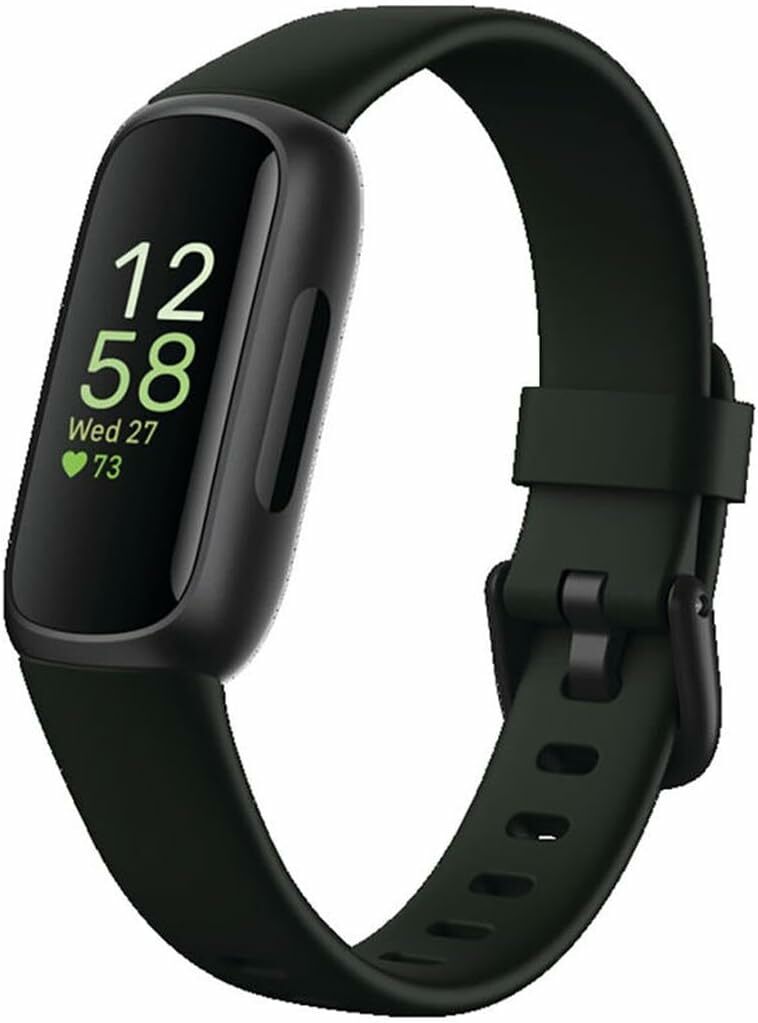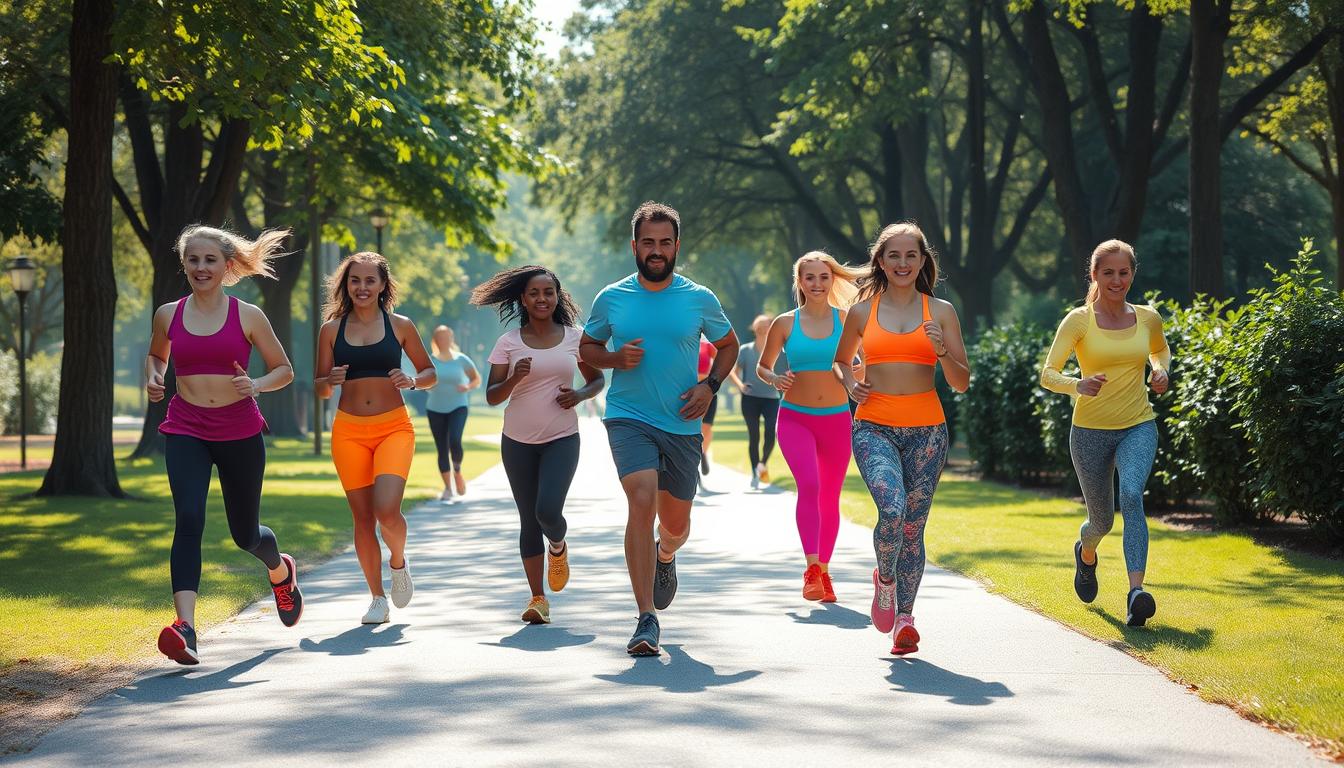Turning a simple walk into a walking workout routine can boost your health. It adds intensity and purpose. This can lead to weight loss, better heart health, and clearer mind.
This article shares five ways to make your walk better. You can try interval training or set goals. These tips will help you get a stronger workout, helping you reach your fitness and weightAre you ready to take your daily stroll to the next level? Walking is one of the simplest and most accessible forms of exercise, but it doesn’t have to be a monotonous routine. In this article, we’re exploring five ways to upgrade your walk to a walking workout that packs a punch. By incorporating these walking fitness tips, you can transform your leisurely walks into effective walking workout routines that help you stay engaged and motivated. Whether you’re aiming to boost your endurance, shed a few pounds, or simply enhance your overall fitness, these strategies will elevate your walking experience and help you reach your health goals faster. Get ready to step up your game!
loss goals.
Key Takeaways
- Interval training boosts calorie burn and heart health.
- Good walking posture and breathing help you last longer and avoid injuries.
- Using hand weights or resistance bands makes your workout harder.
- Walking on different terrains adds more challenge to your walk.
- Using fitness tools to track your progress keeps you motivated and on track.
1. Incorporate Interval Training for Maximum Benefits
Interval training makes your walks better. It pushes your body hard and improves your health. You walk fast and then slow, making your walks more intense.
Understanding Interval Training
Interval training means walking fast and then slow. It makes your walks more interesting and improves your heart health. Start by walking fast for a minute, then slow for two minutes.
How to Start with Simple Intervals
Begin with a 5-minute warm-up. Then, walk fast for 30 seconds to 1 minute. Walk slowly for 2 minutes. Keep doing this and make the fast walks longer as you get stronger.
Benefits of Interval Walking
Interval walking has many benefits. It burns more calories because you walk faster. It also makes your heart stronger and your walks longer.
2. Utilize Proper Walking Techniques
Learning to walk better can make your walks more fun and useful.
Correct Posture While Walking
Walking right is key for safety and getting the most out of your walk. Stand up straight with your shoulders down and look straight ahead. Keep your chin level and your core tight to keep your back straight.
This way, you avoid getting hurt and get the most from your walk.
The Importance of Footwear
Choosing the right shoes is very important for walking. Pick shoes that support your arch, are comfy, and fit well. Don’t choose shoes that are too stiff.
Good shoes help prevent blisters and foot pain and keep you safe from injuries.

Breathing Techniques for Endurance
Good breathing can make you walk longer and stronger. Try breathing in for three steps and out for two. This way, you get more oxygen to your muscles.
This helps you walk longer and harder.
| Walking Technique | Benefits |
|---|---|
| Correct Posture | Prevention of injuries, optimized benefits |
| Proper Footwear | Comfort, injury prevention |
| Rhythmic Breathing | Enhanced endurance, increased stamina |
3. Engage Your Upper Body for a Fuller Workout
Adding upper body moves to your walk makes it better. Simple movements can turn a regular walk into a powerful one.
Using Hand Weights or Resistance Bands
Try using hand weights or resistance bands. Hand weights build muscle endurance. Resistance bands make your muscles work harder with each step.
- Start with light hand weights (1-3 pounds).
- Hold the weights firmly but without straining your grip.
- Use resistance bands with medium tension to avoid excessive strain.

Arm Movements to Enhance Calorie Burn
Good arm movements burn more calories while walking. They raise your heart rate, helping you burn more calories.
Here are some recommended arm techniques:
- Bend your arms at a 90-degree angle.
- Swing your arms naturally as you walk, keeping your movements controlled.
- Ensure your arms move opposite to your legs to maintain balance.
Using these techniques in your power walking will work your upper body well. It makes your workout more effective and complete.
4. Choose Varied Terrain for Increased Challenge
Walking on different terrains can make your workout better. It helps build muscle strength and boosts endurance. Mixing up your routes keeps your fitness journey exciting.
Benefits of Walking on Hills
Walking uphill makes your muscles stronger. It works your legs and glutes harder than flat ground. Hills add challenge to your walks, making them more effective.
Exploring Trails vs. Pavements
Trails and pavements each have their Exploring trails versus pavements offer unique advantages that can significantly enhance your walking experience and overall fitness. Trails, often surrounded by nature, challenge your balance and engage more muscle groups than a flat surface can. The uneven terrain makes you adapt your walking technique improvements, allowing you to strengthen stabilizing muscles that might otherwise go unnoticed. Furthermore, the natural scenery can provide a mental boost, making your walks feel less like a workout and more like a rejuvenating adventure.
On the other hand, walking on pavements provides the benefits of a controlled environment where you can maintain a steady pace. This predictability is ideal for those focused on walking for weight loss, as it allows for more consistent tracking of your speed and distance over time. The smooth surface minimizes the risk of falls, which can be especially beneficial for beginners or those recovering from injury. As you build endurance on pavements, you might find that you’re able to gradually increase your walking intensity, turning a casual stroll into a more effective calorie-burning session.
By mixing both trails and pavements into your walking routine, you can keep your workouts fresh and engaging. Alternating between the two not only prevents monotony but also ensures that you develop a well-rounded walking skill set. You might find that the challenges of trails encourage you to improve your walking technique and increase muscle engagement, while the consistency of pavement walks helps you refine your pacing and intensity. This blend not only contributes to physical fitness but also supports mental health, making your walking practices more holistic.
Ultimately, the choice between trails and pavements boils down to personal preference and fitness goals. Combining the two can lead to a more enriching walking experience that enhances your physical capabilities while supporting mental well-being. Whether you’re strolling through a sun-dappled forest or striding along a city sidewalk, both environments encourage you to embrace the journey of movement and its myriad benefits. Exploring trails versus pavements presents a fascinating contrast in how we engage with our surroundings while walking. Trails, often situated in natural settings like parks, forests, or mountains, offer a unique experience that can elevate both the physical and mental benefits of walking. The variations in terrain, such as hills, roots, or uneven surfaces, challenge the body differently and often lead to boosting walking intensity. This increased effort not only enhances cardiovascular fitness but also strengthens muscles, making each step along a trail feel purposeful. The sights, sounds, and smells of natural environments can further enrich this experience, promoting a sense of peace and well-being.
Conversely, city pavements provide a structured and predictable environment for walkers. Urban landscapes often feature unique architectural elements to admire and dynamic atmospheres filled with the hustle and bustle of everyday life. While flat and even surfaces may require less physical effort than trails, they allow for a consistent pace that can maximize walking benefits, especially for those looking to incorporate walking into their daily routine. Regular walks on pavements can still provide significant health advantages, including improved cardiovascular health and enhanced mood, particularly when those routes are frequented regularly.
In both settings, the act of walking itself becomes an opportunity for self-reflection and stress relief. Whether you prefer the tranquility of nature or the vibrant energy of city life, each environment has something to contribute to your overall health. Engaging with these landscapes encourages individuals to tune into their bodies and the rhythm of their steps, fostering a deeper connection with the environment. With the added potential for social interaction in urban spaces, walking can transform into a communal activity, further boosting its appeal.
Ultimately, the choice between trails and pavements depends on personal preference and goals. For those seeking a more vigorous workout and a break from the daily grind, trails might hold the key to enhancing walking experiences. Meanwhile, those who appreciate the convenience and urban exploration may find joy in the rhythmic cadence of city walking. Regardless of the chosen path, what remains constant is the journey of movement itself and the countless benefits it brings to our physical and mental well-being. When we embark on our daily walks, we often find ourselves faced with a choice: the serene embrace of nature trails or the structured familiarity of city pavements. Each option offers its unique set of experiences and benefits, making the decision a matter of personal preference and circumstance. Trails, often engulfed by lush greenery and the sounds of wildlife, provide us with a tranquil escape from the hustle and bustle of urban life. Walking amidst trees and along streams allows us to connect with nature, which can significantly enhance our mood and reduce stress. The varied terrains of these trails can also challenge our bodies in beneficial ways, promoting overall fitness while maximizing walking benefits.
On the other hand, the rhythmic cadence of city walking brings its own set of advantages. Pavements often lead us through bustling streets filled with vibrant life, where different cultures, shops, and cafes create a rich tapestry of human experience. While these paths might be less forgiving on the joints due to their uniform surfaces, the sheer convenience and accessibility of city walking cannot be overlooked. Incorporating walks into our daily routines, whether it’s to catch public transport or to grab a coffee, allows us to seamlessly integrate movement into our busy lives, a crucial factor for those looking to maximize walking benefits.
Moreover, the social aspect of city walking can’t be overstated. Streets lined with people provide ample opportunities for spontaneous interactions, helping to bolster mental well-being through connections with others. Urban walking can become a communal activity, bringing friends and family together in shared experiences while also introducing us to new acquaintances. In contrast, trails often lead to a more solitary experience, inviting introspection and personal reflection. Both environments cater to different moods and needs, reminding us that the act of walking itself is enriched by the context in which it occurs.
Ultimately, whether we choose the winding paths of nature or the straight lines of city pavements, the journey of movement remains a powerful tool for enhancing our health and well-being. By embracing both types of walking experiences, we can diversify the benefits we receive, allowing our bodies to adapt and flourish in various ways. After all, the heart of walking lies not just in the destination; walking can take on many forms, from meandering along paved sidewalks in urban environments to traversing winding trails in natural settings. While both options offer their unique benefits, exploring trails often provides a richer sensory experience, inviting walkers to immerse themselves in the sights, sounds, and smells of nature. The differences between trails and pavements extend beyond simply the surface underfoot; they can influence the intensity of your walk, your connection to the environment, and even your mental well-being. As we explore the merits of each, we can also discover five ways to upgrade your walk to a walking workout, transforming a leisurely stroll into an invigorating exercise session.
For those who choose the rugged path, walking on trails engages a variety of muscle groups as you navigate uneven terrain, hills, and natural obstacles. This diversity in movement not only strengthens your legs but also improves balance and coordination, enhancing overall fitness. In contrast, walking on paved surfaces can sometimes lead to repetitive motions that may not challenge the body as dynamically. However, by incorporating interval walking—alternating between fast-paced strides and leisurely walks—you can turn a flat road into a workout haven. It’s a simple adjustment that significantly increases cardiovascular benefits while keeping your walks engaging and effective.
Moreover, the psychological advantages of walking in nature are well documented. Trails often offer a tranquil escape from the noise of urban life, allowing our minds to rest and rejuvenate. The act of being surrounded by trees, flowers, and wildlife has been shown to reduce stress and anxiety, fostering a sense of calm that paved roads simply can’t replicate. To elevate this experience, consider adding mindful walking techniques—pay attention to your breathing, take note of the colors around you, and appreciate the rhythm of your steps. This not only enhances the exercise but connects you deeper to your environment.
Whether you choose the path less traveled or the familiar sidewalk, the important takeaway is that both can contribute significantly to your physical and mental health. Embracing a variety of walking environments can keep your routine fresh and full of excitement. Remember, the heart of walking lies not just in the destination walkingWhen considering options for a walk, many individuals are faced with the choice between trails and pavements. Both have their own unique advantages, but exploring trails stands out as a path to not only enjoy nature but also enhance your physical fitness. The varied terrain often found on trails engages different muscle groups, increasing the overall demand of your walk and making it an ideal setting for those looking to elevate their fitness. Dipping into the wilderness not only delights the senses with fresh air and scenic views but also presents an opportunity to switch up the routine and challenge the body more than a flat, monotonous pavement.
For anyone looking to transform a casual stroll into a beneficial walking workout, there are five ways to upgrade your walk to a walking workout. First, adding intervals of brisk walking or jogging can elevate your heart rate, making your session more impactful. Second, incorporating uphill sections or natural inclines present in many trails builds strength and endurance. Third, using trekking poles or incorporating bodyweight exercises, such as squats or lunges, along the route can further engage your muscles. Fourth, being mindful of your posture and taking bigger strides can enhance your calorie burn. Lastly, merging mindfulness practices, like focusing on your breath or the surrounding nature, can turn your walk into a holistic workout for both body and mind.
On the other hand, pavement walks offer their own set of advantages, particularly in accessibility and predictability. Smooth surfaces make them ideal for beginners or those recovering from injuries, providing a steadier ground to walk on. However, the repetitive nature of walking on pavement can lead to overuse injuries and may lack the stimulating variety that trails provide. Additionally, the urban environment often adds distractions, reducing the meditative quality of a walk.
Ultimately, whether one chooses trails or pavements, the key to maximizing the benefits lies in understanding how to manipulate the walking experience. For those seeking an invigorating workout, trails undoubtedly provide an unmatched opportunity to engage with nature while boosting physical fitness. By applying the five strategies to elevate your walk, you can turn even a simple outing into a robust exercise experience, leaving you both rejuvenated and accomplished.
is one of the simplest yet most effective forms of exercise, serving as a gateway for many into the world of physical fitness. Whether you prefer the rugged allure of a natural trail or the smooth predictability of city pavements, each setting offers unique advantages that can enhance your walking experience. Exploring trails can immerse you in the beauty of nature, providing a serene environment that can significantly boost your mental well-being. The varied terrain often found on trails engages different muscle groups, increasing the overall demand of your walk and making it an ideal setting for those looking to elevate their fitness.
On the other hand, walking on pavements allows for a more controlled environment where you can easily track time and distance, focusing on your pace and performance. The straightforward movement in urban settings can be a great way to incorporate social walking; whether it’s joining a friend for a brisk walk around the block or participating in a local walking group, the communal aspect can increase motivation and turn a simple stroll into a dynamic workout. By focusing on where and how you walk, you can discover five ways to upgrade your walk to a walking workout, transforming the mundane into a purposeful exercise.
Incorporating intervals, varying your speed, or even adding light weights can make your walking routine more challenging regardless of whether you’re on a trail or pavement. For trails, try tackling hills or uneven surfaces to build strength and endurance. Conversely, if you’re on city streets, consider incorporating stair climbing or brisk walking with periods of faster-paced intervals. Focusing on your posture and engaging your core during each stride not only enhances the workout but also promotes better overall body mechanics.
Ultimately, the choice between trails and pavements boils down to personal preference and accessibility. Embrace the journey itself, encouraging yourself to step outside of your comfort zone by experimenting with different walking styles. Each environment offers myriad benefits that can enhance your fitness routine, making every walk an opportunity for mental and physical rejuvenation. Pursue what feels right for you, and relish the freedom and joy that comes from simply moving your body in any space.
but in the simple grace of the journey itself. Encourage yourself to step outside of your comfort zone, experiment with different walking styles, and enjoy the myriad benefits that both trails and pavements have to offer.
but in the simple grace of the journey itself.
perks. Trails make you balance better, working more muscles. Pavements are smooth, helping you keep a steady pace. Mixing both keeps your walks interesting and varied.
| Terrain Type | Benefits |
|---|---|
| Hills | Builds muscle strength and endurance |
| Trails | Engages balance and stability |
| Pavements | Consistency and pace control |

Using Stairs as a Workout Tool
Stairs are great for a leg workout. Climbing stairs tones your legs and raises your heart rate. Adding stairs to your routine targets different muscles and boosts your heart health.
5. Track Your Progress with Fitness Tools
Staying motivated on your walking workouts can be hard. Using fitness tracking tools helps you keep track of your progress.
The Importance of Tracking Your Steps
Tracking your steps is more than just counting numbers. It shows how well you stick to your walking plan. By tracking your progress, you can see your achievements and keep going.
This helps you stay focused on your fitness goals. It encourages you to walk more and harder.
Best Walking Apps for Progress Monitoring
Walking apps can change how you track your fitness. Here are some top apps for tracking your walks:
- Map My Walk: Under Armour made this app. It lets you map your walks, track steps, and see how many calories you burn.
- Strava: Athletes love Strava. It tracks your activities well and has a social part to keep you motivated.
- Fitbit: Fitbit users get detailed insights with the app. It shows your heart rate and sleep patterns too.
- Google Fit: This app uses your phone’s sensors to log your activities. It gives tips to boost your fitness.
These tools are key for serious walkers. They give important data and the push you need to keep going every day.

6. Incorporate Music or Podcasts for Motivation
Adding music or podcasts to your walks can help. It makes walking more fun and keeps you moving to the beat.
The Impact of Rhythm on Performance
Rhythm makes walking better. Walking to music with a steady beat helps you keep a good pace. It makes your walk smoother and more fun.
Recommended Playlists for Walking
There are many playlists for walking. They match different walking speeds and tastes. Here are some picks to get you moving:
| Playlist | Type of Walk | Songs Included |
|---|---|---|
| Upbeat Energy | High-Intensity | “Eye of the Tiger” by Survivor, “Uptown Funk” by Bruno Mars |
| Chill Walk | Moderate-Intensity | “Someone Like You” by Adele, “Let Her Go” by Passenger |
| Power Walk | Fast-Paced | “Can’t Stop the Feeling” by Justin Timberlake, “Happy” by Pharrell Williams |
7. Set Goals to Stay Motivated
Setting walking goals is key to staying motivated. It helps you see your progress and celebrate your wins. You can set goals with friends to make it more fun and keep you going.
Short-Term vs. Long-Term Goal Setting
It’s important to have both short and long goals. Short goals give you quick rewards. Long goals help you work towards big achievements.
Creating a Walking Challenge with Friends
Walking with friends can be a great motivator. It makes you feel part of a team. You can all work together to reach a goal or compete in fun challenges.
Use apps or social media to track your steps. This way, you can all see how you’re doing. It makes walking together more fun and keeps you all on track.
FAQ
How can I transform a basic walk into an effective walking workout?
What is interval training, and how does it benefit my walking workout?
Why is proper walking technique important?
How can I engage my upper body during a walking workout?
What are the benefits of walking on varied terrains?
How do fitness tracking tools and walking apps help improve my walking workout?
Fitness tracking tools and walking apps have revolutionized how we approach walking exercise, allowing individuals to turn a simple stroll into a structured and engaging workout. By leveraging technology, these apps provide insights into personal progress, keeping you informed about the distance covered, steps taken, and calories burned. However, their true potential shines in how they help you upgrade your walk to a walking workout, transforming what might seem like an ordinary activity into a focused and effective exercise routine.
One of the most compelling features of fitness trackers and walking apps is their ability to set personalized goals. Whether aiming to hit a specific step count or increase your walking duration, these tools provide a roadmap for improvement. Tracking your walking patterns helps you identify your baseline and then gradually increase your walking pace or distance. Over time, this method of increasing walking calorie burn ensures that you are consistently challenging your body and reaping the benefits of enhanced cardiovascular fitness.
Moreover, many apps incorporate social elements, allowing you to join challenges or connect with friends. This fosters a sense of community and accountability, making it easier to maintain a regular walking routine. Whether you’re engaging in friendly competition or simply sharing your achievements with others, the motivational boost can significantly enhance your commitment to your walking exercise. It’s a fantastic way to keep boredom at bay, as you can constantly discover new routes, trails, or community events that encourage walking as a fun and rewarding activity.
Finally, the adaptability of walking apps means that anyone, regardless of fitness level, can find value in their features. With various plans and suggestions tailored to different goals, the journey toward upgrading your walk into a targeted workout can be seamless and enjoyable. So, embrace the power of technology and start using these tools to craft a walking exercise plan that keeps you engaged, motivated, and moving toward your fitness goals.


